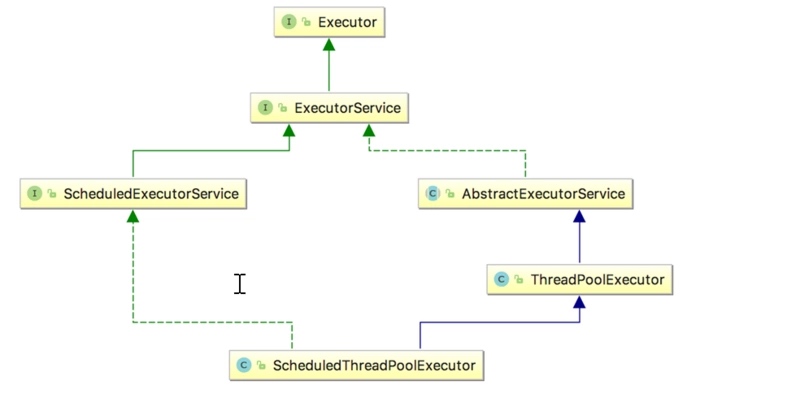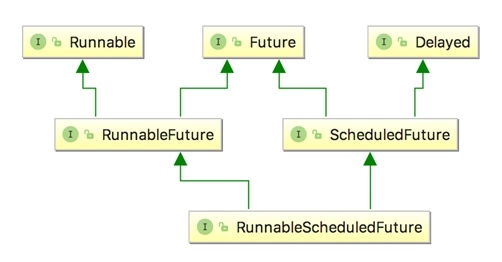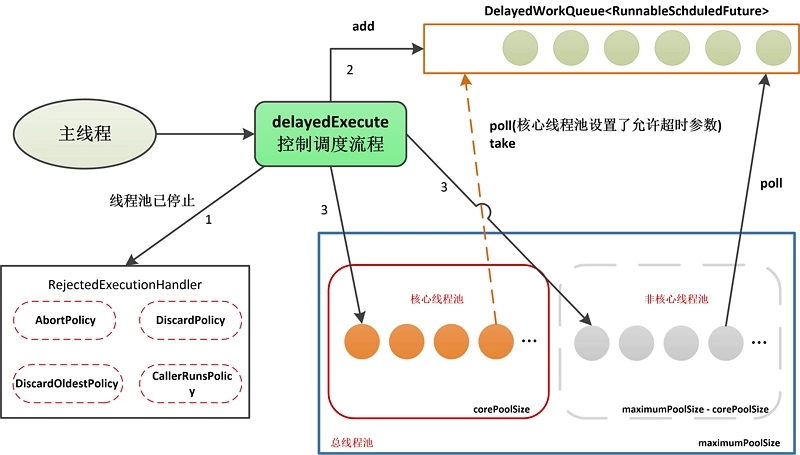转载自:https://segmentfault.com/a/1190000016672638
ScheduledThreadPoolExecutor简介
在executors框架概述一节中,我们曾经提到过一种可对任务进行延迟/周期性调度的执行器(Executor),这类Executor一般实现了ScheduledExecutorService这个接口。ScheduledExecutorService在普通执行器接口(ExecutorService)的基础上引入了Future模式,使得可以限时或周期性地调度任务。
ScheduledThreadPoolExecutor的类继承关系如下图,该图中除了本节要讲解的ScheduledThreadPoolExecutor外,其它部分已经在前2节详细介绍过了:

从上图中可以看到,ScheduledThreadPoolExecutor其实是继承了ThreadPoolExecutor这个普通线程池,我们知道ThreadPoolExecutor中提交的任务都是实现了Runnable接口,但是ScheduledThreadPoolExecutor比较特殊,由于要满足任务的延迟/周期调度功能,它会对所有的Runnable任务都进行包装,包装成一个RunnableScheduledFuture任务。

RunnableScheduledFuture是Future模式中的一个接口,关于Future模式,我们后续会专门章节讲解,这里只要知道RunnableScheduledFuture的作用就是可以异步地执行【延时/周期任务】。
另外,我们知道在ThreadPoolExecutor中,需要指定一个阻塞队列作为任务队列。ScheduledThreadPoolExecutor中也一样,不过特殊的是,ScheduledThreadPoolExecutor中的任务队列是一种特殊的延时队列(DelayQueue)。
我们曾经在juc-collections框架中,分析过该种阻塞队列,DelayQueue底层基于优先队列(PriorityQueue)实现,是一种“堆”结构,通过该种阻塞队列可以实现任务的延迟到期执行(即每次从队列获取的任务都是最先到期的任务)。
ScheduledThreadPoolExecutor在内部定义了DelayQueue的变种——DelayedWorkQueue,它和DelayQueue类似,只不过要求所有入队元素必须实现RunnableScheduledFuture接口。
ScheduledThreadPoolExecutor基本原理
构造线程池
我们先来看下ScheduledThreadPoolExecutor的构造,其实在executors框架概述中讲Executors时已经接触过了,Executors使用newScheduledThreadPool工厂方法创建ScheduledThreadPoolExecutor:
public static ScheduledExecutorService newScheduledThreadPool(int corePoolSize) {
return new ScheduledThreadPoolExecutor(corePoolSize);
}
public static ScheduledExecutorService newScheduledThreadPool(int corePoolSize, ThreadFactory threadFactory) {
return new ScheduledThreadPoolExecutor(corePoolSize, threadFactory);
}
我们来看下ScheduledThreadPoolExecutor的构造器,内部其实都是调用了父类ThreadPoolExecutor的构造器,这里最需要注意的就是任务队列的选择——DelayedWorkQueue,我们后面会详细介绍它的实现原理。
public ScheduledThreadPoolExecutor(int corePoolSize) {
super(corePoolSize, Integer.MAX_VALUE, 0, NANOSECONDS, new DelayedWorkQueue());
}
public ScheduledThreadPoolExecutor(int corePoolSize, ThreadFactory threadFactory) {
super(corePoolSize, Integer.MAX_VALUE, 0, NANOSECONDS, new DelayedWorkQueue(), threadFactory);
}
public ScheduledThreadPoolExecutor(int corePoolSize, RejectedExecutionHandler handler) {
super(corePoolSize, Integer.MAX_VALUE, 0, NANOSECONDS, new DelayedWorkQueue(), handler);
}
public ScheduledThreadPoolExecutor(int corePoolSize, ThreadFactory threadFactory, RejectedExecutionHandler handler) {
super(corePoolSize, Integer.MAX_VALUE, 0, NANOSECONDS, new DelayedWorkQueue(), threadFactory, handler);
}
线程池的调度
ScheduledThreadPoolExecutor的核心调度方法是schedule、scheduleAtFixedRate、scheduleWithFixedDelay,我们通过schedule方法来看下整个调度流程:
public ScheduledFuture<?> schedule(Runnable command, long delay, TimeUnit unit) {
if (command == null || unit == null)
throw new NullPointerException();
RunnableScheduledFuture<?> t = decorateTask(command, new ScheduledFutureTask<Void>(command, null,
triggerTime(delay, unit)));
delayedExecute(t);
return t;
}
上述的decorateTask方法把Runnable任务包装成ScheduledFutureTask,用户可以根据自己的需要覆写该方法:
protected <V> RunnableScheduledFuture<V> decorateTask(Runnable runnable, RunnableScheduledFuture<V> task) {
return task;
}
注意:ScheduledFutureTask是RunnableScheduledFuture接口的实现类,任务通过period字段来表示任务类型
private class ScheduledFutureTask<V> extends FutureTask<V> implements RunnableScheduledFuture<V> {
/**
* 任务序号, 自增唯一
*/
private final long sequenceNumber;
/**
* 首次执行的时间点
*/
private long time;
/**
* 0: 非周期任务
* >0: fixed-rate任务
* <0: fixed-delay任务
*/
private final long period;
/**
* 在堆中的索引
*/
int heapIndex;
ScheduledFutureTask(Runnable r, V result, long ns) {
super(r, result);
this.time = ns;
this.period = 0;
this.sequenceNumber = sequencer.getAndIncrement();
}
// ...
}
ScheduledThreadPoolExecutor中的任务队列——DelayedWorkQueue,保存的元素就是ScheduledFutureTask。DelayedWorkQueue是一种堆结构,time最小的任务会排在堆顶(表示最早过期),每次出队都是取堆顶元素,这样最快到期的任务就会被先执行。如果两个ScheduledFutureTask的time相同,就比较它们的序号——sequenceNumber,序号小的代表先被提交,所以就会先执行。
schedule的核心是其中的delayedExecute方法:
private void delayedExecute(RunnableScheduledFuture<?> task) {
if (isShutdown()) // 线程池已关闭
reject(task); // 任务拒绝策略
else {
super.getQueue().add(task); // 将任务入队
// 如果线程池已关闭且该任务是非周期任务, 则将其从队列移除
if (isShutdown() && !canRunInCurrentRunState(task.isPeriodic()) && remove(task))
task.cancel(false); // 取消任务
else
ensurePrestart(); // 添加一个工作线程
}
}
通过delayedExecute可以看出,ScheduledThreadPoolExecutor的整个任务调度流程大致如下图:

我们来分析这个过程:
- 首先,任务被提交到线程池后,会判断线程池的状态,如果不是RUNNING状态会执行拒绝策略。
- 然后,将任务添加到阻塞队列中。(注意,由于DelayedWorkQueue是无界队列,所以一定会add成功)
- 然后,会创建一个工作线程,加入到核心线程池或者非核心线程池:
void ensurePrestart() {
int wc = workerCountOf(ctl.get());
if (wc < corePoolSize)
addWorker(null, true);
else if (wc == 0)
addWorker(null, false);
}
通过ensurePrestart可以看到,如果核心线程池未满,则新建的工作线程会被放到核心线程池中。如果核心线程池已经满了,ScheduledThreadPoolExecutor不会像ThreadPoolExecutor那样再去创建归属于非核心线程池的工作线程,而是直接返回。也就是说,在ScheduledThreadPoolExecutor中,一旦核心线程池满了,就不会再去创建工作线程。
这里思考一点,什么时候会执行else if (wc == 0)创建一个归属于非核心线程池的工作线程?答案是:当通过setCorePoolSize方法设置核心线程池大小为0时,这里必须要保证任务能够被执行,所以会创建一个工作线程,放到非核心线程池中。
最后,线程池中的工作线程会去任务队列获取任务并执行,当任务被执行完成后,如果该任务是周期任务,则会重置time字段,并重新插入队列中,等待下次执行。这里注意从队列中获取元素的方法:
- 对于核心线程池中的工作线程来说,如果没有超时设置(allowCoreThreadTimeOut == false),则会使用阻塞方法take获取任务(因为没有超时限制,所以会一直等待直到队列中有任务);如果设置了超时,则会使用poll方法(方法入参需要超时时间),超时还没拿到任务的话,该工作线程就会被回收。
- 对于非工作线程来说,都是调用poll获取队列元素,超时取不到任务就会被回收。
上述就是ScheduledThreadPoolExecutor的核心调度流程,通过我们的分析可以看出,相比ThreadPoolExecutor,ScheduledThreadPoolExecutor主要有以下几点不同:
- 总体的调度控制流程略有区别;
- 任务的执行方式有所区别;
- 任务队列的选择不同。
最后,我们来看下ScheduledThreadPoolExecutor中的延时队列——DelayedWorkQueue。
延时队列
DelayedWorkQueue,该队列和已经介绍过的DelayQueue区别不大,只不过队列元素是RunnableScheduledFuture:
static class DelayedWorkQueue extends AbstractQueue<Runnable> implements BlockingQueue<Runnable> {
private static final int INITIAL_CAPACITY = 16;
private RunnableScheduledFuture<?>[] queue = new RunnableScheduledFuture<?>[INITIAL_CAPACITY];
private int size = 0;
private final ReentrantLock lock = new ReentrantLock();
private final Condition available = lock.newCondition();
private Thread leader = null;
// ...
}
DelayedWorkQueue是一个无界队列,在队列元素满了以后会自动扩容,它并没有像DelayQueue那样,将队列操作委托给PriorityQueue,而是自己重新实现了一遍堆的核心操作——上浮、下沉。我这里不再赘述这些堆操作,读者可以参考PriorityBlockingQueue自行阅读源码。
我们关键来看下add、take、poll这三个队列方法,因为ScheduledThreadPoolExecutor的核心调度流程中使用到了这三个方法:
public boolean add(Runnable e) {
return offer(e);
}
public boolean offer(Runnable e, long timeout, TimeUnit unit) {
return offer(e);
}
add、offer内部都调用了下面这个方法:
public boolean offer(Runnable x) {
if (x == null)
throw new NullPointerException();
RunnableScheduledFuture<?> e = (RunnableScheduledFuture<?>) x;
final ReentrantLock lock = this.lock;
lock.lock();
try {
int i = size; // 队列已满, 扩容
if (i >= queue.length)
grow();
size = i + 1;
if (i == 0) {
queue[0] = e;
setIndex(e, 0);
} else {
siftUp(i, e); // 堆上浮操作
}
if (queue[0] == e) { // 当前元素是首个元素
leader = null;
available.signal(); // 唤醒一个等待线程
}
} finally {
lock.unlock();
}
return true;
}
take方法:
public RunnableScheduledFuture<?> take() throws InterruptedException {
final ReentrantLock lock = this.lock;
lock.lockInterruptibly();
try {
for (; ; ) {
RunnableScheduledFuture<?> first = queue[0];
if (first == null) // 队列为空
available.await(); // 等待元素入队
else {
long delay = first.getDelay(NANOSECONDS);
if (delay <= 0) // 元素已到期
return finishPoll(first);
// 执行到此处, 说明队首元素还未到期
first = null;
if (leader != null)
available.await();
else {
// 当前线程成功leader线程
Thread thisThread = Thread.currentThread();
leader = thisThread;
try {
available.awaitNanos(delay);
} finally {
if (leader == thisThread)
leader = null;
}
}
}
}
} finally {
if (leader == null && queue[0] != null)
available.signal();
lock.unlock();
}
}
注意:上述leader表示一个等待获取队首元素的出队线程,这是一种称为“Leader-Follower pattern”的多线程设计模式(读者可以参考DelayQueue中的讲解)。
每次出队元素时,如果队列为空或者队首元素还未到期,线程就会在condition条件队列等待。一般的思路是无限等待,直到出现一个入队线程,入队元素后将一个出队线程唤醒。
为了提升性能,当队列非空时,用leader保存第一个到来并尝试出队的线程,并设置它的等待时间为队首元素的剩余期限,这样当元素过期后,线程也就自己唤醒了,不需要入队线程唤醒。这样做的好处就是提升一些性能。
总结
本节介绍了ScheduledThreadPoolExecutor,它是对普通线程池ThreadPoolExecutor的扩展,增加了延时调度、周期调度任务的功能。概括下ScheduledThreadPoolExecutor的主要特点:
- 对Runnable任务进行包装,封装成ScheduledFutureTask,该类任务支持任务的周期执行、延迟执行;
- 采用DelayedWorkQueue作为任务队列。该队列是无界队列,所以任务一定能添加成功,但是当工作线程尝试从队列取任务执行时,只有最先到期的任务会出队,如果没有任务或者队首任务未到期,则工作线程会阻塞;
- ScheduledThreadPoolExecutor的任务调度流程与ThreadPoolExecutor略有区别,最大的区别就是,先往队列添加任务,然后创建工作线程执行任务。
另外,maximumPoolSize这个参数对ScheduledThreadPoolExecutor其实并没有作用,因为除非把corePoolSize设置为0,这种情况下ScheduledThreadPoolExecutor只会创建一个属于非核心线程池的工作线程;否则,ScheduledThreadPoolExecutor只会新建归属于核心线程池的工作线程,一旦核心线程池满了,就不再新建工作线程。